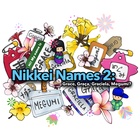“You can’t give her a Japanese name. It will ruin her life.” My grandmother Marjorie Julia pleaded with her son, Gregory Michael, my father, on the day I was born.
My parents gave me the name, Midori Faye, despite having zero proficiency in Japanese, and despite my grandmother’s wishes. After all, her good ol’ American name, Marjorie Julia, protected her and kept her Japanese identity a secret (or so she hoped). I can’t blame her for wanting to keep me safe from what she endured. My grandmother watched her mother, Helen Sadame, go through life with an American first name and a secret Japanese middle name. Those Japanese names needed to be their secrets, especially in the years surrounding World War II.
My grandmother’s aunts—like their sister Helen Sadame—all had Japanese middle names, too. Their secret Japanese names were given to them by their Issei parents like precious treasures to keep our culture hidden, but alive nonetheless: Mary Meriko, Anna Haruko, Lorraine Miyoko, Betty Sueko.Their Issei father, my great-great grandfather, was Yasoichi Sato when he left Okayama in September 1906. By October of the same year, he was Frank, once he arrived in Oregon.
His wife, my great-great grandmother, went by Koye her whole life, even after immigrating. I’ll never know why she kept that name—despite its potential dangers—but I’d like to think it was her defiance in the face of hate or her stubbornness to keep her Japanese identity intact. I wonder if I inherited some of that from her. I wonder what those ancestors would have thought of my name, Midori Faye.
What I do know is that those ancestors—even the ones I never got to meet—speak to me through my Japanese name.
I will admit that my grandma Marjorie Julia was right that I didn’t have the same protective shield that her American name gave her. Growing up in America with a Japanese name meant decades of:
“What did you say? Midora?”
“Oh, I am not going to remember that name. That is way too difficult.”
“Have you considered going by Dori instead?”
Statements like those make my name temporarily feel like my shame, especially when I hear it mocked or pronounced incorrectly. So, it is a confusing sensation to feel liberated by my name. The most recent occurrence was during a pilgrimage to Yasoichi Sato Frank’s and Koye’s home in Okayama. Being mixed in Japan means that not many strangers can track me as having Japanese ancestry. I wonder things like, Is it my accidental rude etiquette? Or maybe my elementary school language skills? Or perhaps my curvy body? But when I introduce myself as Midori to Japanese strangers, they claim me. In Japan, Midori Faye transforms into my golden ticket to connection; it is no longer my shame.
On that same pilgrimage, I spent time in Hiroshima, paying respects to the ancestors who died in 1945 and to the land in its healing process. There are forty-nine documented people with the name Midori who died on August sixth. They all have mischief and sass in their eyes, like me. My soul feels tied to them. I didn’t know any other Midoris growing up in America, but these forty-nine Midoris make my name not feel so exotic or lonely. Even though I never got to meet them, these Midori’s are the ancestors who remind me to be proud of the name Midori Faye.
My relationship with my name continues to evolve. Sometimes, I’m privileged to have it. Sometimes, it’s best if I keep it a secret. Sometimes I wish I didn’t have to hide. And as history changes, so might my relationship with Midori Faye. But today, I meditate on the lessons learned from my name. I learn from these conversations with the ancestors who speak to me through my beautiful Japanese name.
Midori Faye is proof that our Japanese American family is not bound by war, assimilation, humiliation, hate, erasure, or secrets.
Midori Faye is proof that our Japanese American family is resilient and no longer needs to conceal.
Midori Faye is proof that, despite the war’s best efforts, our culture, our people survived.
© 2024 Midori Samson
Nima-kai Favorites
Each article submitted to this Nikkei Chronicles special series was eligible for selection as the community favorite. Thank you to everyone who voted!











